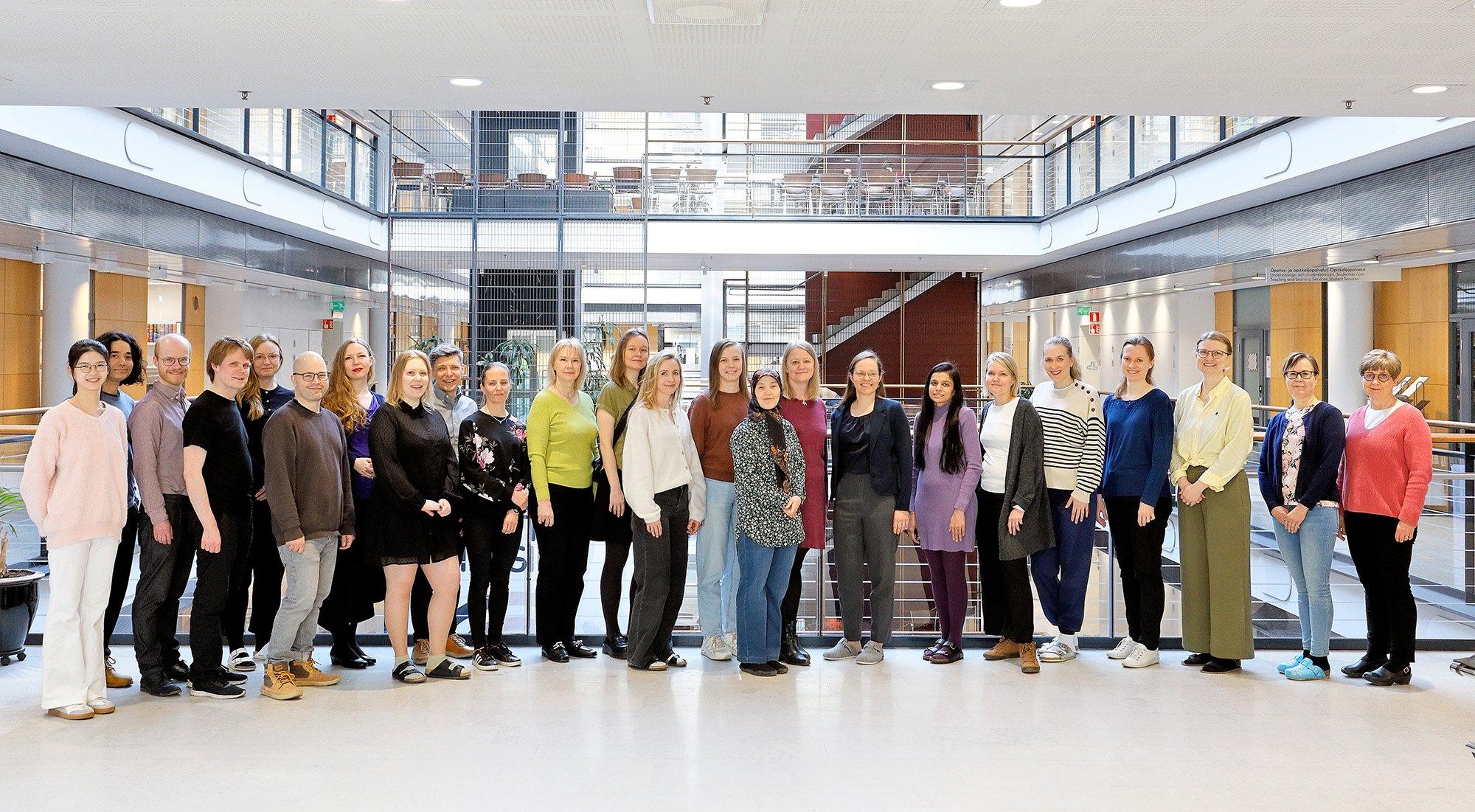The FinnDiane Study

Our research
Diabetes is a major health issue affecting millions of people worldwide. It can lead to serious complications like kidney disease, heart problems, and vision loss, which significantly impact quality of life and increase healthcare costs. The Finnish Diabetic Nephropathy Study, FinnDiane, is a large-scale research project focused on understanding and preventing complications in people with Type 1 Diabetes (T1D). Established in 1997, FinnDiane involves over 10,000 participants from across Finland.
The study aims to identify genetic, clinical, and environmental factors that contribute to complications. Our ultimate goal is to enhance the quality of life for people with T1D by providing insights that lead to better prevention and treatment strategies for diabetic complications.
The main aim is to elucidate why one third of the patients develop diabetic nephropathy with subsequent risk of macrovascular disease and premature death. Understanding the interplay between the environment, genes and lifestyle may help identify people at risk and may help tailoring personalized preventative measures, and ultimately, to improve the quality of life of people with diabetes.
We have identified a number of environmental, life style and genetic risk factors associated with the risk of diabetic complications.

One particular interest is to understand the potential deleterious effect of the chronic exposure to bacterial compounds and an inflammatory gut to the kidney health. Another promising hypothesis is diabetes-induced hypoxia that can cause irreversible damage to tissues through a number of downstream effects. Major efforts are made to dissect the genetic landscape of diabetic complications by employing state-of-the-art methods such as genome-wide association studies, exome- and whole genome sequencing, and epigenetics.
We have identified multiple genetic factors that affect the risk of diabetic kidney disease, diabetic retinopathy, cardiovascular disease and blood glucose balance. As one of the largest studies participating in an international collaboration including 19,406 individuals with type 1 diabetes, we identified 16 novel genetic factors, including a common missense variant of COL4A3 gene that reduced the risk of diabetic kidney disease. With the ongoing sequencing efforts, we aim to identify also rare genetic factors that may have a larger impact on the risk of diabetic complications on individual level.
Kort om studien på svenska
Den finländska studien om diabetisk nefropati, FinnDiane, är ett storskaligt forskningsprojekt som fokuserar på att förstå och förebygga komplikationer hos personer med typ 1-diabetes (T1D).
Read more
Principal Investigators
Niina Sandholm, Principal Investigator
Lena Thorn, Principal Clinical Investigator
Co-Principal Investigators
Per-Henrik Groop, Group Leader Emeritus
Valma Harjutsalo
Markku Lehto
Senior scientists
Stefan Mutter
Johan Wadén
Postdoctoral Researchers
Krishna Adeshara
Emma Dahlström
Marika Eriksson
Maija Feodoroff
Jani Haukka
Stefanie Hägg-Holmberg
Fanny Jansson Sigfrids
Anmol Kumar
Raija Lithovius
Jenna Nicklén
Hanne Salmenkari
Rasmus Simonsen
Anna Syreeni
Doctoral Researchers
Soheila Akhondzadeh
Anni Antikainen
Rebecka Bergdahl
Johanna Blomqvist
Tor-Björn Claesson
Emilia Franzén
Mari-Anne Härma
Jussi Inkeri
Jaroslaw Karcz
Iiris Kyläheiko
Xiaoqi Luo
Anniina Pirttiniemi
Kaarina Rimpeläinen
Susanna Satuli-Autere
Patrik Smidtslund
Aleksi Tarkkonen
Anniina Tynjälä
Erkka Valo
Nadja Vuori Holopainen
Anni Ylinen
Visiting Scientists
Daniel Gordin
Milla Kallio
Sari Mäkimattila
Nicolae Panduru
Erika Parente
Drazenka Pongrac
Lars Stechemesser
Staff
Anna Sandelin (Head nurse)
Carina Brandstetter
Anu Dufva
Valtteri Itkonen
Heli Krigsman
Arna Merikallio
Hanna Olanne
Erik Ramm-Schmidt
Jonna-Riikka Saastamoinen
Ann-Sofie Sundbäck
Kirsi Uljala
Undergraduate Students
Axel Häyry
Sara Itkonen
Melinda Karkola
Joanna Kouki
Senja Iskala
Minea Lassas
Frida Lindholm
Milla Miettunen
Ida Olme
Johanna Soininen
Milla Vienonen
Julianne Vilos
Genome-wide association study of diabetic kidney disease highlights biology involved in renal basement membrane collagen.
Salem RM, Todd JN, Sandholm N, Cole JB, Chen W-M, Andrews D, Pezzolesi MG, McKeigue PM, Hiraki LT, Qiu C, Nair V, Di Liao C, Cao JJ, Valo E, Onengut-Gumuscu S, Smiles AM, McGurnaghan SJ, Haukka J, Harjutsalo V, Brennan E, Van Zuydam N, Ahlqvist E, Doyle R, Ahluwalia T, Lajer M, Hughes M, Park J, Skupien J, Spiliopoulou A, Liu A, Menon R, Boustany-Kari CM, Kang HM, Nelson RG, Klein R, Klein B, Lee K, Gao X, Mauer M, Maestroni S, Caramori ML, de Boer IH, Miller R, Gao J, Boright AP, Tregouet D, Gyorgy B, Snell-Bergeon JK, Maahs DM, Bull SB, Canty AJ, Palmer C, Stechemesser L, Paulweber B, Witgasser R, Sokolovska J, Rovite V, Pirags V, Prakapiene E, Radzeviciene L, Verkauskiene R, Panduru NM, Groop LC, McCarthyM, Gu H, Möllsten A, Falhammar H, Brismar K, Martin F, Rossing P, Costacou T, Zerbini G, Marre M, Hadjadj S, McKnight AJ, Forsblom C, McKay G, Godson C, Maxwell AP, Kretzler M, Susztak K, Colhoun HM, Krolewski A, Paterson AD, Groop P-H, Rich SS, Hirschhorn JN, Florez JC. Journal of the American Society of Nephrology. 2019.
The association between bacterial infections and the risk of coronary heart disease in type 1 diabetes.
Simonsen R, Järvinen A, Harjutsalo V, Forsblom C, Lehto M, Groop P-H, FinnDiane Study Group. Journal of Internal Medicine. 2020.
Long-term population-based trends in the incidence of cardiovascular disease in individuals with type 1 diabetes from Finland: a retrospective, nationwide, cohort study.
Harjutsalo V, Pongrac Barlovic D, Groop PH. The Lancet Diabetes & Endocrinology. 2021.
The relationship between body fat distribution and non-alcoholic fatty liver in adults with type 1 diabetes.
Parente EB, Dahlström E, Harjutsalo V, Inkeri JM, Mutter S, Forsblom C, Sandholm N, Gordin D, Groop P-H, FinnDiane Study Group. Diabetes Care 2021.
Urinary metabolite profiling identifies biomarkers for risk of progression of diabetic nehropathy in 2670 individuals with type 1 diabetes.
Mutter S, Valo E, Aittomäki V, Nybo K, Raivonen L, Thorn LM, Forsblom C, Sandholm N, Würtz, Peter, Groop P-H. Diabetologia 2021.
Incidence rate patterns, cumulative incidence, and time trends for moderate and severe albuminuria in individuals diagnosed with type 1 diabetes aged 0-14 years: a population-based retrospective cohort study.
Jansson Sigfrids F, Groop PH, Harjutsalo V. The Lancet Diabetes & Endocrinology. 2022.
Prognosis After First-Ever Myocardial Infarction in Type 1 Diabetes Is Strongly Affected by Chronic Kidney Disease.
Smidtslund P, Jansson Sigfrids F, Ylinen A, Elonen N, Harjutsalo V, Groop PH, Thorn LM. Diabetes Care. 2023.
Epigenome-wide meta-analysis identifies DNA methylation biomarkers associated with diabetic kidney disease.
Smyth LJ*, Dahlström EH*, Syreeni A, Kerr K, Kilner J, Doyle R, Brennan E, Nair V, Fermin D, Nelson RG, Looker HC, Wooster C, Andrews D, Anderson K, McKay GJ, Cole JB, Salem RM, Conlon PJ, Kretzler M, Hirschhorn JN, Sadlier D, Godson C, Florez JC, GENIE consortium, Forsblom C, Maxwell AP, Groop PH, Sandholm N, McKnight AJ. Nature Communications. 2022.
Residual insulin secretion in individuals with type 1 diabetes in Finland: longitudinal and cross-sectional analyses.
Harsunen M*, Haukka J*, Harjutsalo V, Mars N, Syreeni A, Härkönen T, Käräjämäki A, Ilonen J, Knip M, Sandholm N, Miettinen PJ, Groop PH, Tuomi T. Lancet Diabetes Endocrinology. 2023.
Whole-exome and whole-genome sequencing of 1064 individuals with type 1 diabetes reveals novel genes for diabetic kidney disease.
Haukka JK, Antikainen AA, Valo E, Syreeni A, Dahlström EH, Lin BM, Franceschini N, Krolewski AS, Harjutsalo V, Groop PH, Sandholm N, FinnDiane Study Group.
Diabetologia. 2024.
National
Prof. Johan Eriksson (Folkhälsan Research Center, University of Helsinki)
Prof. Leif Groop (University of Helsinki and University of Lund, Sweden)
Prof. Sohvi Hörkkö (University of Oulu)
Doc. Matti Jauhiainen (University of Helsinki)
Doc. Juha Kirveskari (University of Helsinki)
Prof. Mikael Knip (University of Helsinki)
Prof. Sanna Lehtonen (University of Helsinki)
Doc. Markus Metsälä (University of Helsinki)
Prof. Markus Perola (University of Helsinki)
Prof. Kirsi Pietiläinen (University of Helsinki)
Doc. Pirkko Pussinen (University of Helsinki)
Doc. Jukka Putaala (University of Helsinki)
Doc. Paula Summanen (University of Helsinki)
Prof. Marja-Riitta Taskinen (University of Helsinki)
Prof. Heikki Tikkanen (University of Eastern Finland, University of Helsinki)
Prof. Ilkka Tikkanen (University of Helsinki)
Doc. Tiinamaija Tuomi (Folkhälsan Research Center, University of Helsinki)
International
Prof. Helen Colhoun (University of Edinburgh, UK)
Prof. Mark Cooper (Monash University, Australia)
Prof. Assam El-Osta (Monash University, Australia)
Ass. Prof. Paola Fioretto (University of Padova, Italy)
Prof. Jose Florez (Harvard University, USA)
Prof. Allan Flyvbjerg (University of Aarhus and Copenhagen, Denmark),
Prof. Alessia Fornoni (University of Miami, USA)
Prof. Catherine Godson (University of Dublin, Ireland)
Prof. Maria Gomez (University of Lund, Sweden)
Prof. Samy Hadjadj (University of Poitiers, France)
Prof. Joel Hirschhorn (Harvard University, USA)
Prof. Harry Holthöfer (University of Freiburg, Germany)
Prof. Alicia Jenkins (Baker Heart and Diabetes Institute, Melbourne, VIC, Australia)
Prof. Matthias Kretzler (University of Michigan)
Prof. Andrzej S. Krolewski (Harvard University, USA)
Ass. Prof. Christine Maric (NIH, USA)
Prof. A. Peter Maxwell (University of Belfast, UK)
Prof. Amy Jayne McKnight (University of Belfast, UK)
Ass. Prof. Andrew Patterson (University of Toronto, Canada)
Prof. Massimo Porta (University of Torino, Italy)
Prof. Peter Rossing (University of Aarhus and Copenhagen, Denmark)
Prof. Kumar Sharma (University of San Diego, USA)
Prof. Katalin Susztak (University of Pennsylvania, USA)
Prof. Karl Tryggvason (University of DukeNUS, Singapore)
Prof. Xia Yang (University of California, USA)
Finnish Diabetes Research Foundation
Finska Läkaresällskapet (Finnish Medical Society)
Folkhälsan Research Foundation
Innovate UK
Juvenile Diabetes Research Foundation
Medicinska Understödsföreningen Liv och Hälsa (“Life and Health Medical Fund”)
National Institutes of Health (NIH)
Novo Nordisk Foundation
Signe and Ane Gyllenberg Foundation
The Helsinki University Central Hospital Research Funds
University of Helsinki funded doctoral program
Wilhelm and Else Stockmann Foundation
Sigrid Juselius Foundation

